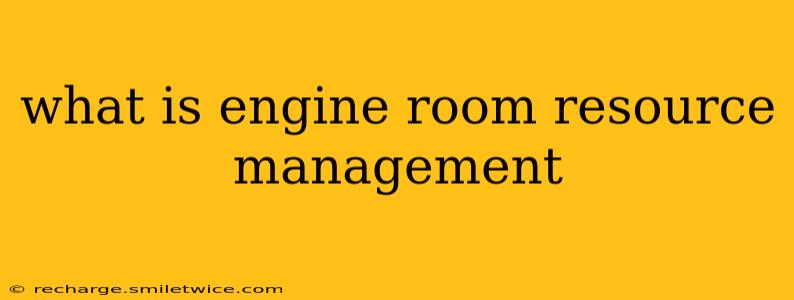Engine Room Resource Management (ERRM) is a crucial system implemented in the maritime industry, particularly on ships with complex engine rooms. It's a proactive approach to managing the resources—human, material, and technical—within the engine room to ensure safe, efficient, and reliable operation. It goes beyond simply maintaining machinery; it's about optimizing the entire engine room environment for peak performance and preventing incidents. Think of it as a holistic approach to engine room safety and efficiency.
Why is ERRM Important?
Modern ships rely on highly sophisticated and interconnected engine room systems. A single point of failure can have cascading effects, leading to significant downtime, financial losses, and even safety hazards. ERRM aims to mitigate these risks by:
- Improving Safety: By proactively identifying and mitigating potential hazards, ERRM significantly reduces the risk of accidents and injuries within the engine room.
- Enhancing Efficiency: Optimizing resource allocation leads to reduced fuel consumption, minimized maintenance downtime, and improved overall operational efficiency.
- Boosting Reliability: Proactive maintenance and risk management contribute to greater reliability of the ship's propulsion and auxiliary systems.
- Facilitating Effective Teamwork: ERRM fosters communication and collaboration among engine room personnel, improving coordination and response to unexpected situations.
Key Components of ERRM
Effective ERRM relies on several key components:
- Standard Operating Procedures (SOPs): Clearly defined procedures for all engine room operations ensure consistency and reduce the risk of errors.
- Risk Assessment and Management: Regularly identifying and assessing potential hazards, and implementing control measures to mitigate those risks.
- Communication and Teamwork: Effective communication channels and clear roles and responsibilities within the team are critical for efficient response to emergencies and everyday operations.
- Training and Competency: Well-trained and competent personnel are essential for the effective implementation of ERRM. Regular training updates and competency assessments are crucial.
- Maintenance and Planned Preventative Maintenance (PPM): A proactive maintenance schedule prevents breakdowns and ensures the continued reliability of the engine room equipment.
- Emergency Response Planning: Having well-defined emergency response plans and conducting regular drills ensures preparedness for unexpected events.
How is ERRM Implemented?
ERRM implementation isn't a one-size-fits-all solution. It requires a tailored approach based on the specific needs of the vessel and its crew. However, some common practices include:
- Regular meetings and briefings: To discuss ongoing tasks, potential hazards, and planned maintenance.
- Use of checklists and logs: To track maintenance, inspections, and potential issues.
- Utilizing technology: For instance, computerized maintenance management systems (CMMS) can help streamline maintenance processes and track performance.
- Continuous improvement: Regularly reviewing and refining ERRM procedures based on lessons learned and best practices.
What are the benefits of a good ERRM system?
A well-implemented ERRM system provides numerous benefits:
- Reduced downtime: Proactive maintenance minimizes unexpected breakdowns.
- Lower operational costs: Improved efficiency translates to reduced fuel consumption and maintenance expenses.
- Improved crew morale: A safe and efficient work environment boosts crew satisfaction and motivation.
- Enhanced reputation: A strong safety record enhances the ship's reputation and attracts better crew.
- Compliance with regulations: ERRM aligns with international maritime regulations and standards.
What are some common challenges in implementing ERRM?
Despite its benefits, implementing ERRM can face several challenges:
- Resistance to change: Crew members may be resistant to adopting new procedures and technologies.
- Lack of training: Inadequate training can hinder the effective implementation of ERRM.
- Insufficient resources: Lack of adequate funding or personnel can limit the effectiveness of ERRM.
- Communication barriers: Language barriers or poor communication can impede effective teamwork.
By addressing these challenges proactively and fostering a culture of safety and continuous improvement, shipping companies can maximize the benefits of ERRM, leading to safer, more efficient, and reliable operations. The ultimate goal is a smoothly functioning engine room that contributes to the overall success of the vessel.
